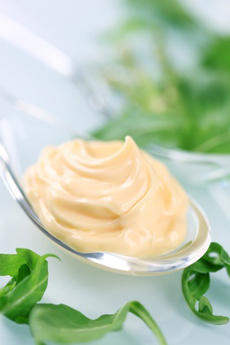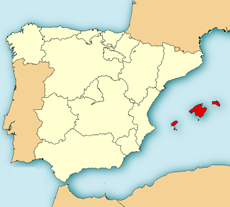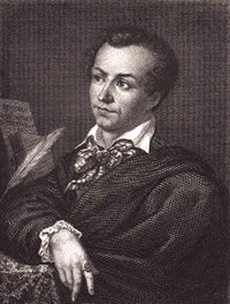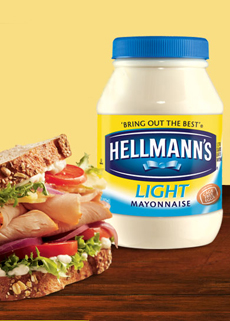

Sauce, spread, binder, garnish and dip: what would we do without mayonnaise? Photo © Viktor | Fotolia.
KAREN HOCHMAN is Editorial Director of THE NIBBLE.
|
August 2010
|
 |
The History Of Mayonnaise
Page 1: There Can Be No Egg Salad Until Mayonnaise Is Invented
CAPSULE REPORT: Get beyond those bland blobs of egg-and-mayo (so much mayo that it makes bread soggy). Here we present great egg salad recipes, along with the history of mayonnaise, without which there would be no egg salad. This is Page 1 of a three-page article.
The History Of Mayonnaise
Which came first, the mayo or the egg?
Most assuredly it was the egg, since mayonnaise as we know it today did not appear until the 1800s.
While some culinary historians observe that a mayonnaise-like mixture of olive oil and egg was consumed by ancient Egyptians and Romans, the mayonnaise that we know today—an emulsion of oil, egg and lemon juice and/or vinegar, plus seasonings—was developed by one of the great chefs of France. Join us for a moment in this story:
While stories of the provenance of almost any food will vary, the leading belief is that the concept for the original mayonnaise sauce was brought back to France in 1756 from Mahón, a city on Minorca in the Balearic Islands, off the northeast coast of Spain.
What became one of the world’s favorite condiments was created for a victory banquet to celebrate the capture of Mahón by forces under Louis-François-Armand de Vignerot du Plessis, duc de Richelieu (1696-1788), a marshal of France and a grandnephew of Cardinal Richelieu.* |
|

Minorca, the birthplace of mayonnaise, is the easternmost of the three Balearic Islands, now part of Spain. Mahón is on the bottom half of the island. Map courtesy Wikimedia. |
____________________
*Literary note: The Duke was an accomplished military strategist and diplomat, attaining these distinctions despite his reputation as a man of exceptionally loose morals. Reportedly, the writer Pierre Choderlos de Laclos based the character Valmont in Les Liaisons Dangereuses on him.
____________________
Traditional sauces of the day were made of cream and eggs. As the story goes, the Duke’s chef had no cream and substituted olive oil, naming the new sauce “Mahónnaise” in honor of the victory. There are various reasons given for the evolution of the word to mayonnaise—from typographical error to the old French word for egg yolk, moyen and manier, to stir or to blend.
What we do know is that years after its debut, the great French chef Marie-Antoine Carême (1784-1833), founder of the concept of haute cuisine†, lightened the original recipe by blending the vegetable oil and egg yolks into an emulsion. It was his recipe that became famous throughout Europe, and subsequently, the United States and the world.
The History Of Sauces
Sauces were invented as cooking mediums, meat tenderizers and flavor enhancers. Each culture developed its own style, using favored ingredients and techniques.
The history of modern French sauces began during the reign of Louis XIV, with the great chef François Pierre La Varenne (1618-1678). La Varenne authored the founding cookbook of modern French cuisine in 1651, Le cuisinier françois (“The French Chef”). This cookbook, written for professionals, was a revolution, departing from medieval French cookery preferences and codifying the modern French cuisine.
|
|

The great French chef Marie-Antoine Carême created the mayonnaise we know today.
Photo courtesy Wikimedia. |
__________________
†A few differences: Out: heavy spices. In: the natural flavor of foods. Out: Exotic spices (saffron, cinnamon, cumin, ginger, nutmeg, cardamom, nigella, seeds of paradise). In: local herbs—bay leaf, chervil, parsley, sage, tarragon, thyme). In: fresh vegetables and fish instead of preparations that masked the ingredients.
__________________
The French concept of mother sauces (sauces mères) developed in the 18th century. Mayonnaise is one of the five seminal mother sauces, which also include sauce espagnole, tomato sauce, béchamel, velouté and hollandaise.‡
______________
‡Espagnole is brown sauce with tomatoes; béchamel is white sauce; hollandaise is an emulsion of egg yolk and butter, usually seasoned with lemon juice, salt and pepper; velouté is a stock thickened with butter and flour (roux). All other French sauces are variations on these base sauces.
______________________
Mayonnaise In America
Mayonnaise was a product made at home. Here’s how one of the world’s most famous brands of mayonnaise came to be, according to Unilever, owners of the Hellmann’s brand:
In 1903, Richard Hellmann emigrated to New York City from Germany. Two years later he opened a delicatessen. His wife’s recipe for mayonnaise was used in the salads. The mayo was so good that customers asked to buy it. As take-out packaging at a neighborhood deli was limited in those days, Hellmann began selling it the mayonnaise in the “wooden boats” that were used for weighing butter.
Ultimately, the mayonnaise made it into jars. At that time, two variations of the recipe were sold. To distinguish between them, Hellmann put a blue ribbon around one version.
The “blue ribbon” recipe was in such high demand that in 1912, Hellmann designed a label with a blue ribbon at the top. In the (almost) century since, the label has undergone many evolutions, but a small blue ribbon, more modern than the original, still appears—moved down a bit. |
|

The blue ribbon on the label has endured for a century. Photo courtesy Hellmann’s. |
As Hellmann’s Mayonnaise was booming in the East, Best Foods, Inc. introduced mayonnaise to Californian consumers. In 1932, there was a meeting of the mayos, as Richard Hellmann, Inc. was acquired by Best Foods, Inc., which was in turn acquired by Unilever, an enormous Anglo-Dutch multinational corporation, in 2000.
Continue To Page 2: Egg Salad
Go To The Article Index Above

|